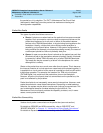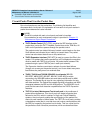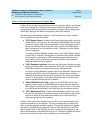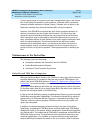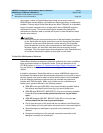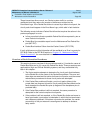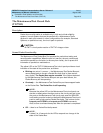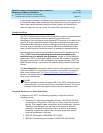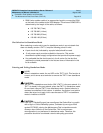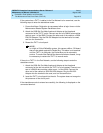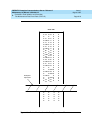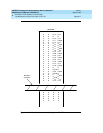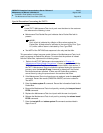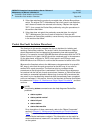
DEFINITY Enterprise Communications Server Release 6
Maintenance for R6vs/si
555-230-127
Issue 1
August 1997
Packet Bus Fault Isolation and Correction
Page 9-12The Maintenance/Test Circuit Pack (TN771D)
9
4. D8W 8-wire modular cable of an appropriate length to connect the 258A
on the back of the cabinet to the 355A adapter. The relevant COMCODE is
determined by the length of the cable, as follows:
■ 103 786 786 (7 feet)
■ 103 786 802 (14 feet)
■ 103 786 828 (25 feet)
■ 103 866 109 (50 feet)
Slot Selection for Standalone Mode
When selecting a carrier slot to use for standalone mode in a port network that
does not already contain a TN771, keep the following points in mind:
■ A port circuit slot (indicated by a purple label) should be used.
■ -5 volt power supply must be available in the carrier. This section
describes the power supply configurations that provide this power supply.
■ It is preferable that the slot chosen is in the A carrier if a free slot that
matches the criteria presented in the first two items of information in this
list is available.
Entering and Exiting Standalone Mode
NOTE:
When in standalone mode, the red LED on the TN771 is lit. This function is
correct, and it serves as a reminder to remove the TN771 from standalone
mode.
!
CAUTION:
The TN771 in standalone must be the ONLY TN771 in the port network. If a
TN771 is already in the port network, place that TN771 in standalone mode.
Do not insert a second TN771 into standalone mode. System behavior is
rendered as undefined if this is done. In addition, the system is not able to
detect the extra circuit pack in this case because a TN771 in standalone
mode is invisible to the SPE.
!
CAUTION:
If the TN771 Packet Bus port has reconfigured the Packet Bus in a switch
with a High or Critical Reliability system, (indicated by error type 2049
against PKT-BUS), placing the Maintenance/Test in standalone mode
causes a loss of service to the Packet Bus. This is true because
reconfiguration is not performed in standalone mode. Therefore, this
procedure should be considered a service-disrupting procedure.



